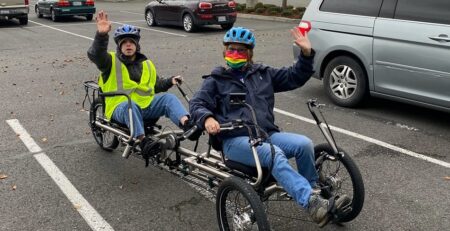BICYCLE SAFETY GUIDELINES

Sequim is a “Bicycle Friendly Community” designated by the League of American Bicyclists. Our relatively dry climate makes cycling a desirable mode of transportation as well as recreation. Because we encourage cycling in the City and surrounding area, both drivers of vehicles and cyclists should be aware of the following information from the State of Washington:
- State RCW 46.61.755 says that Traffic laws apply to persons riding bicycles.
- Bicycles are legally considered “vehicles” on Washington’s roadways.
- That means bicyclists must obey the rules of the road like drivers of any other vehicle and must be treated as equal users by all other vehicles.
- The best way to avoid collisions is to be prepared and be aware of other vehicles around you.
In addition, the City encourages bicyclists to keep in mind these important safety tips:
- Obey traffic signs and signals—Bicycles must follow the rules of the road like other vehicles.
- Never ride against traffic—Motorists aren’t looking for bicyclists riding on the wrong side of the road. State law and common sense require that bicyclists drive like other vehicles.
- Follow lane markings—Don’t turn left from the right lane. Don’t go straight in a lane marked “right turn only.”
- Don’t pass on the right—Motorists may not look for or see a bicycle passing on the right.
- Scan the road behind you—Learn to look over your shoulder without losing your balance or swerving. Some riders use rear-view mirrors.
- Keep both hands ready to brake—You may not stop in time if you brake one-handed. Allow distance for stopping in the rain, since brakes are less efficient when wet.
- Wear a helmet and never ride with headphones—Always wear a helmet. Never wear headphones when riding a bike.
- Dress for the weather—In rain wear a poncho or waterproof suit. Dress in layers so you can adjust to temperature changes. Wear bright colored clothing.
- Use hand signals—Hand signals tell motorists and pedestrians what you intend to do. Signal as a matter of law, courtesy, and of self-protection.
- Ride in the middle of the lane in slower traffic—Get in the middle of the lane at busy intersections and whenever you are moving at the same speed as traffic.
- Choose the best way to turn left—There are two choices 1) Like an auto: signal to move to the left lane and then turn left. 2) Like a pedestrian: ride straight to the far side crosswalk and walk your bike across.
- Make eye contact with drivers—Assume that the drivers don’t see you until you are sure that they do. Eye contact is important with any driver who might pose a threat to your safety.
- Look out for road hazards–Watch out for parallel-slat sewer grates, gravel, ice, sand or debris. Cross railroad tracks at right angles.
- Use lights at night—The law requires a white headlight (visible from at least 500 feet ahead) and a rear reflector or taillight (visible up to 300 feet behind.).
- Keep your bike in good repair—Adjust your bike to fit you and keep it working properly. Check brakes and tires regularly. Routine maintenance is simple and you can learn to do it yourself.










Comment (1)
Good tips !
Comments are closed.